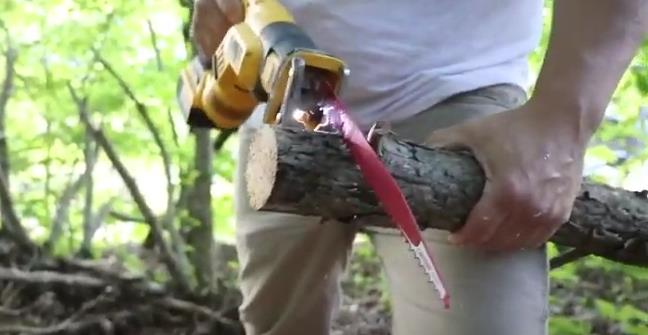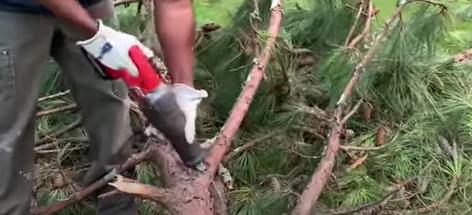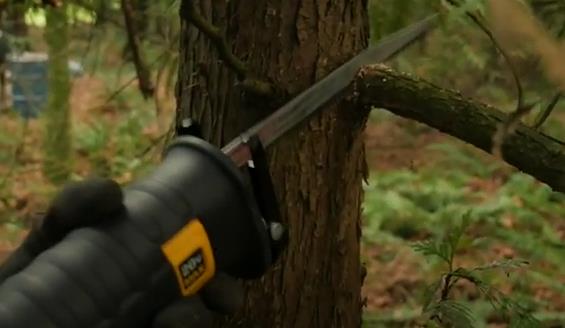Cut the tree limbs with a reciprocating saw by following the manufacturer’s instructions.
Can I use a reciprocating saw to cut tree limbs safely and effectively? The answer is yes, but you can do it with some crucial concerns.
A reciprocating saw, also known as a “Sawzall,” is a versatile power tool that can be used for a variety of cutting tasks. One of the most common uses for a reciprocating saw is cutting tree limbs.
These saws are known for their speed and efficiency and can make quick work of cutting through even thick tree limbs. But before you start sawing away, it’s important to understand the proper technique and safety precautions for using a reciprocating saw on trees.
In this blog post, we’ll explore the ins and outs of using a reciprocating saw for tree maintenance and give you the information you need to tackle your next tree-trimming project with confidence.
So, if you want to learn the best way to prune your trees and keep them healthy, keep reading
Can I Use A Reciprocating Saw To Cut Tree Limbs
Yes, you can use a reciprocating saw to cut tree limbs.

A reciprocating saw can be used to cut tree limbs. It is a powerful tool that can make quick work of even large branches with its rapid back-and-forth motion.
However, the best way to cut tree limbs depends on the specific saw you are using and the type of tree you are working with.
Here are some general tips that can help to ensure a safe and successful cutting operation:
- Make sure the blade is sharp and in good condition. A dull blade will not cut well and could cause hurt.
- Use a stable platform – The saw’s motion must be smooth and consistent for it to operate effectively. If the platform is unstable, the saw will start to shake and could become dangerous.
- Apply even pressure when cutting – Be careful not to apply too much force, as this could cause the limb to break or deform unexpectedly. Try to keep your cuts shallow enough so that the limb does not split open completely on the opposite side of the trunk from where you are cutting from.
- Cut only between the limb’s main trunk and the first major branch. Doing so will reduce the risk of damaging your tree further down the line.
- Use a proper cutting guide if available. These guides provide accurate lines to follow while sawing so you don’t end up injuring yourself or your tree.
- Always wear safety gear when using a reciprocating saw. This includes a face shield, safety goggles, and hearing protection.
How To Use A Reciprocating Saw For Tree Limb Cutting?
Using a reciprocating saw for tree limb cutting can be done in a few simple steps:

Choose the right blade:
Select a wood-cutting blade specifically designed for cutting tree limbs. This type of blade is typically made from high-carbon steel and is designed to handle the density and thickness of the wood.
Set the speed:
Adjust the speed of the saw to the appropriate level for the task at hand. A higher speed may be needed for thicker branches, while a lower speed may be better for thinner branches.
Make the cut:
Position the saw blade at the point where you want to make the cut, and engage the trigger. Move the saw back and forth to make the cut, keeping the saw moving in a steady and controlled manner to avoid binding or kickback.
Be safe:
Always wear proper safety gear such as eye and ear protection, work gloves, and a hard hat before starting any cutting task. Keep your body and limbs away from the blade while cutting, maintain a firm grip on the saw, and keep a safe distance from the saw.
Finish the cut:
Once the limb is cut through, you can release the trigger and safely remove the limb. Take a look at the tree’s overall structure and prune any other branches that may be diseased or dead.
Before using a tool, it’s always best to have the right training or know how to use it. And it’s also important to maintain your saw and prolong its lifespan, as this will make the job easier and safer for you.
What Is The Best Way To Hold A Reciprocating Saw When Cutting Tree Limbs?
Use both hands to grip the saw firmly, and position your body so that you can apply pressure evenly with both arms.

When cutting tree limbs with a reciprocating saw, it is important to hold the saw correctly in order to avoid injury and get the best results.
Here is a step-by-step guide to holding a reciprocating saw correctly when cutting tree limbs:
- First, make sure that the saw is unplugged.
- Place your left hand on the front of the saw, near the blade.
- Place your right hand on the back of the saw, near the handle.
- Use your left hand to guide the saw blade as you cut through the tree limb.
- Keep your right hand on the back of the saw for stability.
- When you are finished cutting, unplug the saw and set it down carefully.
Proper training and knowledge of the tool are important before using it. Always wear proper safety gear, such as eye and ear protection, work gloves, and a hard hat before starting any cutting task.
Here is an example of how to properly hold a reciprocating saw when cutting tree limbs:
In this picture, the person is cutting a tree limb with a reciprocating saw. Their left hand is on the front of the saw near the blade, while their right hand is on the back of the saw near the handle. You can see that their left hand is guiding the saw blade as they cut through the tree limb.
What Is The Best Blade To Use When Cutting Tree Limbs With A Reciprocating Saw?
The best blade to use when cutting tree limbs with a reciprocating saw is a wood-cutting blade.
When it comes to cutting tree limbs with a reciprocating saw, there are a few different blade options to choose from. Here is a look at some of the best blades to use for this type of job:
Standard Wood Cutting Blade:
A standard blade is a type of reciprocating saw blade that is designed for cutting wood materials. These are typically made from high carbon steel blades. That makes it durable and long-lasting. They are suitable for cutting tree limbs, lumber, and other wood materials. It is designed to cut through wood quickly and easily.
Pruning Blade:
A pruning blade is a good option to use if you need to make precision cuts. It is also good for cutting through smaller limbs. These blades are typically made from high-carbon steel, which is durable and long-lasting. They have razor-sharp teeth for a precise and clean cut, which helps to promote healthy tree growth.
Metal Cutting Blade:
A metal cutting blade is a type of reciprocating saw blade that is designed for cutting metal materials. These blades are normally constructed from high-speed steel or bi-metal, which are durable and able to withstand high temperatures generated during the cutting process. They are suitable for cutting metal pipes, sheet metal, and other metal materials.
Multi-Purpose Blade:
A multi-purpose blade is a type of reciprocating saw blade that is designed to cut a variety of materials, including wood, metal, and plastic. These blades are generally created from high-carbon steel and bi-metal, which provide durability and longevity. They are suitable for a wide range of cutting tasks and are a great option for those who need versatile blades for different projects.
Diamond Grit Blade:
A diamond grit blade is designed for cutting hard, abrasive materials such as tile, masonry, and concrete. These blades are typically made from a diamond abrasive material, which is known for its durability and longevity.
They are suitable for cutting materials that would wear out traditional blades quickly and are perfect for cutting through tough materials like ceramic, porcelain, and marble.
When choosing a blade for cutting tree limbs, it is important to consider the material you will be cutting and the size of the limb. The type of blade you use will also depend on the reciprocating saw you are using. Make sure to read the manufacturer’s instructions carefully before choosing a blade.
Benefits Of Using A Reciprocating Saw For Tree Limb Cutting
There are several benefits of using a reciprocating saw for tree limb cutting.
Here are shared some of the most common benefits of using a reciprocating saw for tree limb cutting:
- Speed and efficiency: The rapid back-and-forth motion of the blade allows for quick cutting of even large branches, making the job faster and more efficient.
- Precision and control: The precision and control of the saw allow for accurate cuts. That can be difficult to achieve with manual tools. Making it easier to shape and prune trees.
- Reach tight spaces and angles: The compact size of the saw and its ability to pivot the blade make it easy to cut the target branch. That is hard to reach with other tools. It also allows you to reach tight spaces and angles.
- Versatility: Reciprocating saws can be used for a sort of cutting mission. Which makes them versatile tools to have in your toolbox.
- Power: Reciprocating saws are powerful tools that can make quick work of the even larger branch. This can save time and energy compared to using manual cutting tools.
- Safety: With proper safety precautions and the use of appropriate blades, reciprocating saws can be used safely for cutting tree limbs.
It’s always recommended to have proper training or knowledge of the tool before using it. And it’s also important to maintain your saw and prolong its lifespan as it will make the job easier and safer for you.
FAQ
How Can I Avoid Cutting Myself When Using A Reciprocating Saw To Cut Tree Limbs?
What Are Some Safety Tips To Follow When Using A Reciprocating Saw To Cut Tree Limbs?
Sum Up
In conclusion, a reciprocating saw can be an effective tool for cutting tree limbs, but it is important to use it safely and correctly. Always wear protective gear, such as eye and ear protection, and use a saw with a blade specifically designed for cutting wood.
It is also important to be mindful of the size and condition of the limb you are cutting, as well as the surrounding area, to avoid causing damage or injury. With proper use and care, a reciprocating saw can be a valuable tool for maintaining and shaping your trees.
Hopefully, you are clear now on how to use a reciprocating saw to cut tree limbs. If you still have any questions, feel free to comment below.

